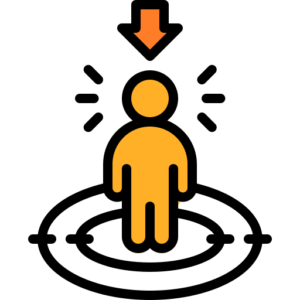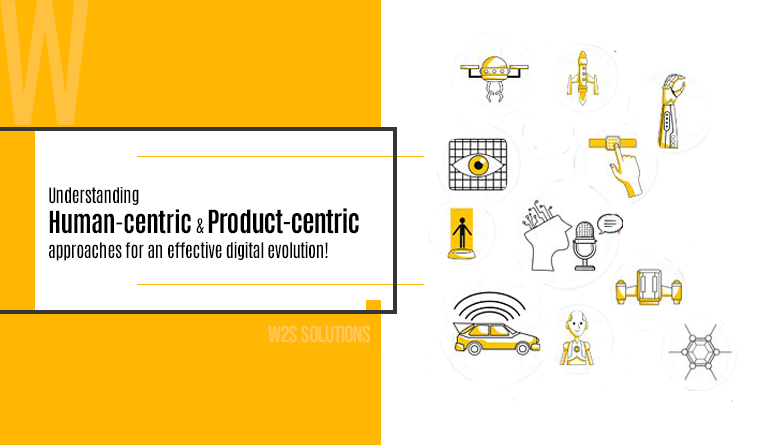Overview:
Every year, some challenges keep pushing business limits beyond expectations. They dealt with the pressure and kept up with the fast-paced world by embracing digital transformation. Many small and large-scale companies are rethinking and transforming their business models to be completely digital to assist customers in the future better. Back then, it was too complex to process a business operation, but today, with digital transformation being inevitable, it is possible to meet the end goals of the business with ease by bridging human-centric and product-centric approaches. Are you excited to know how digital transformation will bridge human and product-centric strategies for your dream business? – Keep reading!
The world is rapidly growing with innovations, ideas, and technology that have empowered future businesses to adopt digital transformation. The human-centric transformation has been around for a while, but businesses have had trouble putting it into practice. Thanks to the growth of remote work, it is now simpler to include multiple people in a transformation process regardless of location or time zone. According to the study, $1.8 trillion will be spent on digital transformation (DX) by 2022. Global spending on digital transformation is anticipated to reach $2.8 trillion by 2025.
Businesses are frequently beginning their digital transformation journeys by updating their technological environment. The excitement surrounding more recent technologies like cloud, big data, blockchain, etc., encourages many firms to concentrate on technology implementation. It is difficult for these firms to gain from digital transformation projects because they still use outdated organizational structures. It is quite challenging to change your organizational structure once you’ve begun a digital transformation journey, resulting in a limited amount of value generated from such activities.
Human-centric transformation:

The human experience remains the main focus of the digital transformation because of the human-centered approach. Many firms frequently concentrate on the technology capabilities embraced to undergo digital transformation. Even though having the right technology is crucial, it only provides a partial view. Businesses must rethink how they use technology in combination with people and processes to create new business opportunities and revenue streams. Businesses can gain professional support from data science consulting firms and start transformational programs that improve customer experiences while promoting innovation and growth to live up to these expectations.
Product-centric transformation:

A product-centric strategy is ideal for embracing digital technologies and scalability because it has a high possibility of growth and profitability. Focusing on areas where digital innovation initiatives have room to expand, such as supporting a new business model, is how an organization should migrate to becoming product-centric. Product-centric strategies from a digital product agency make it easier to create and iterate quickly since they focus on the user experience, changing requirements, and the service or product’s strategic differentiation.
How bridging human-centric and product-centric approaches work?
Big enterprises used to be predominantly built using techniques that were product-centric. However, due to human evolution, businesses are gradually moving toward a human-centric strategy obtained from enterprise digital transformation services. Modern businesses’ biggest problem is deciding between a human-centric and a product-centric approach. These two approaches are two perspectives of the same thing. Neither can exist without the other. However, businesses are assessing the effectiveness of both strategies to determine their advantages and disadvantages. The best solution, theoretically, entails combining the advantages of the two approaches. A human-centric approach is becoming a more powerful strategy for fostering business growth due to the changing nature of competition and consumer behavior. Product-centric approach, however, should not be completely disregarded because it also benefits the company.
Human-centric and Product-centric approach using Big Data and Cloud:
-
Big Data:
Big data is developing, moving from small, isolated, and narrowly targeted projects to an enterprise-wide paradigm. Human-centric and product-centric approaches to using big data must be transformed to do all of this. Early adopters of big data strategies will benefit from a considerable learning curve advantage, which will increase the adoption of enterprise-wide analytics. This will lead to competitive advantages both now and in the future. Hire top mobile app developers to make use of big data solutions to enrich their business growth.
Building a data-driven business strategy and culture that will become a prerequisite for any firm will be the biggest challenge. The ability to keep up with the complicated procedures that will enable enterprise-wide data use and group insights, particularly for IT, will be another challenge. With big data analytics solutions from big data consulting services, it is possible to predict future outcomes and act responsibly to benefit both human-centric and product-centric approaches.
-
Cloud Computing:
In the most recent research into cloud computing technology, organizations are using cloud service models and deployment strategies to deliver their applications. Cloud technology for a human-centric approach obtained from cloud consulting services has benefited businesses and people from more cloud storage space, sharing enormous data, and access to the cloud from anywhere. Enterprises widely prefer the cloud for its speed, reliability, flexibility, and accessibility.
Enterprises have adopted the digital transformation shift towards cloud technology to create a remote infrastructure, increase workers’ productivity, and manage personal life. Data storage in the cloud will always be secured, and there are no chances for hacking or performing vulnerable activities. Cloud is designed to look human-centric and product-centric for businesses and individuals to use based on their requirements efficiently. Businesses can build progressive web applications with the cloud to improve their speed and accessibility for better use.
Read Also – How Cloud Computing Is Transforming Enterprises To Be More Flexible And Agile?
Human-centric benefits:
-
Leverage human sentiments:
When solutions are created with the humans in mind, human success is reflected in all facets of your business, including marketing, sales, support, and product development. Humans will develop favorable attitudes when they feel appreciated as partners in your company. This mindset is necessary to create brand loyalty that persists for future generations.
-
Low entry-barrier:
There is already a market available for you to take advantage of because you created your product after thoroughly examining human wants. All you need to do is market your products successfully to convince people that you are offering what they need. Once you choose the strategic approach, your firm can grow swiftly.
-
More sustainable:
It’s a way of life to be human-centric. You don’t just unveil the product to the whole public and disappear. To maintain your product stability, you must constantly monitor how people’s requirements change. The long-term longevity of your brand is ensured with a sustainable business strategy by sticking with this plan.
Read Also – The Right Mix Of Technology And Business Strategy: Secret Formula!
Product-centric benefits:
-
Building reputation:
You can use a product-centric strategy to establish your brand’s reputation in the market by providing high-quality products. If you succeed in your field, people will recognize you as having the best product to sell. Compared to other forms, its reputation is the longest-lasting.
-
Customer Loyalty:
It’s been proven that creating a reliance on your product will improve customer loyalty. Customers who grow addicted to your product won’t ever consider leaving your business if it has high-quality engagement strategies that provide them with continual value.
-
Focused approach:
Being product-centric implies putting all of your attention on producing your product, which is what you do best. You should focus all of your efforts on developing the industry’s best product, according to the “product-led growth” theory. This saves a ton of time and work.
You can also view more of our works and case studies here!
Final Thoughts:
The market for human-centric and product-centric approaches is in high demand. It would help if you thoroughly understood the products or services your firm offers to select the appropriate strategy. If you are creating an innovative, new product whose demand has not yet been satisfied by the market, you should adopt a product-centric approach. Going human-centric is more realistic if there is a market for a human need already and there are many competitors. If you embrace a human-centric approach, you could build your business sustainably with steady development. Enterprises willing to kickstart their dream business can connect with the world’s leading digital transformation consultants to avail of cost-effective big data solutions with the best approach to achieve their end goals quickly.






